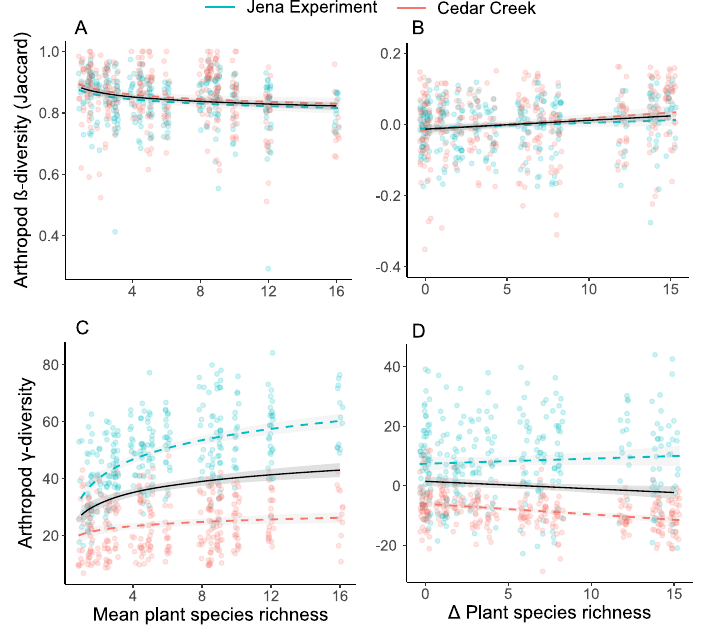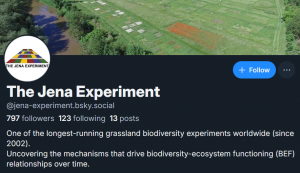New publication from Ebeling et al in Ecology: Contrasting effects of plant diversity on β‐ and γ‐diversity of grassland invertebrates
Contrasting effects of plant diversity on β‐ and γ‐diversity of grassland invertebrates
Abstract:

The diversity of primary producers strongly affects the structure and diversity of species assemblages at other trophic levels. However, limited knowledge exists of how plant diversity effects at small spatial scales propagate to consumer communities at larger spatial scales. We assessed arthropod community β and γ‐diversity in response to experimentally manipulated plant community richness in two long‐term grassland biodiversity experiments (Jena, Germany and Cedar Creek, USA) replicated over two years. We calculated arthropod species turnover among all plot combinations (β‐diversity), and accumulated number of arthropod species occurring on (1) all pairwise plot combinations and (2) 40 randomly selected six‐plot combinations (γ‐diversity). The components of arthropod diversity were tested against two measures of plant diversity, namely average plant α‐diversity (PSR) and the average difference in plant α‐diversity between plots (ΔPSR). Whereas PSR points to the overall importance of plant α‐diversity for arthropod community turnover and diversity on a larger scale, ΔPSR represents the role of habitat heterogeneity. We demonstrate that arthropod γ‐diversity is supported by high, homogeneous plant α‐diversity, despite lower arthropod β‐diversity among high‐ compared to low‐diversity plant communities. We also show that, in six‐plot combinations, average plant α‐diversity has a positive influence on arthropod γ‐diversity only when homogeneity in plant α‐diversity is also high. Varying heterogeneity in six‐plot combinations showed that combinations consisting solely of plots with an intermediate level of plant α‐diversity support a higher number of arthropod species compared to combinations that contain a mix of high‐ and low‐diversity plots. In fact, equal levels of arthropod diversity were found for six‐plot combinations with only intermediate or high plant α‐diversity, due to saturating benefits of local and larger‐scale plant diversity for higher trophic levels. Our results, alongside those of recent observational studies, strongly suggest that maintaining high α‐diversity in plant communities is important for conserving multiple components of arthropod diversity. As arthropods carry out a range of essential ecosystem functions, such as pollination and natural pest‐control, our findings provide crucial insight for effective planning of human‐dominated landscapes to maximize both ecological and economic benefits in grassland systems.

Reference:
Ebeling, A., E. W. Lind, S. T. Meyer, A. D. Barnes, E. T. Borer, N. Eisenhauer, et al. 2020. Contrasting effects of plant diversity on beta- and gamma-diversity of grassland invertebrates. Ecology 101:e03057. https://doi.org/10.1002/ecy.3057



